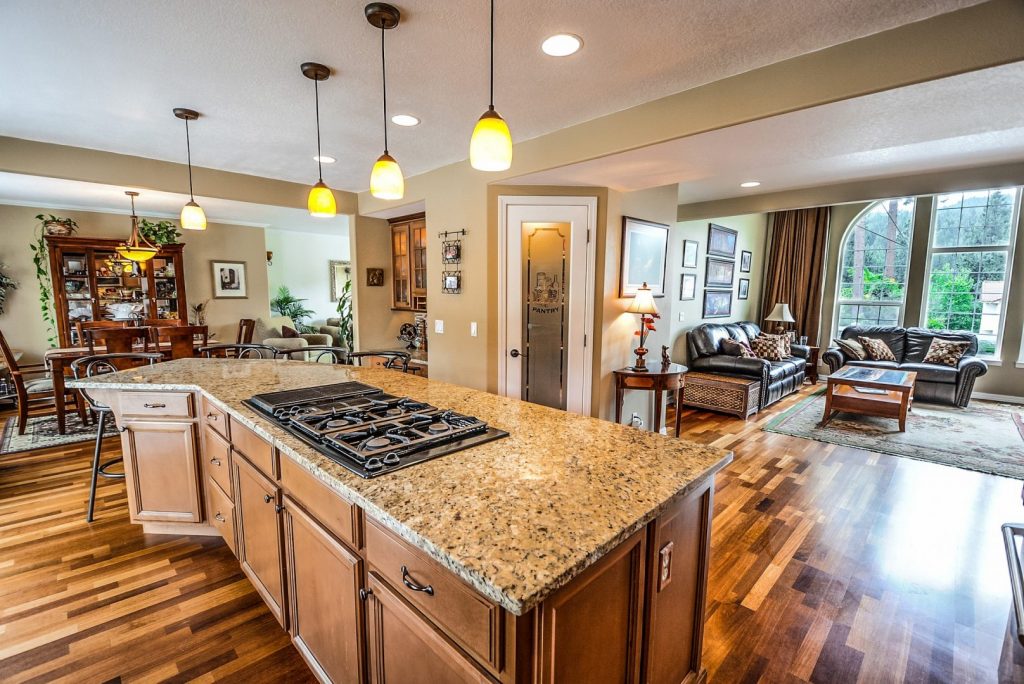
An open concept with good access, plenty of lighting, lower sills, and hard-surface flooring make this home suitable for use by many people, and an accessible counter would be even better
Universal design is a term that is frequently used to describe or suggest improvements that people are making in their homes or that they are considering to allow the people in that home to function effectively. That may or may not be an appropriate use of the term.
With universal design, there is no distinction between someone with mobility difficulties, limitations, or needs, such as the need to use a wheelchair, walker, crutches, cane, or leg braces to move about. It does not care if someone can climb stairs because stairs are eliminated and therefore not a factor. It doesn’t care if people can reach objects in the home unless there are more severe or strenuous limitations than vision, height, reach, balance, grasping, hand control, finger dexterity, or range of motion from a seated or standing position, tall or short of stature, child or adult in age, because objects that need to be used or accessed by the majority of people in the home are at of an acceptable design and height from the floor.
Conversely, aging in place designs and emphasis deal with specific individuals and their home. Universal design or accessibility may be the chief strategy for helping people to use their home more effectively and efficiently, but it might be something designed just for their limited and specific use and not with others in mind. After all, aging in place solutions are personal, whereas universal design is more global in nature.
As people are aging in place in their homes, they often need specific solutions to make their lives safer and more comfortable. Sometimes these modifications that are sought and implemented – especially for seniors – are termed universal by those installing or creating them and by the people receiving them, but they really aren’t. In some cases, they may be, and that is great when they are, but this is not a requirement of creating such solutions. That doesn’t diminish their usefulness, helpfulness, or the need for them, they just may not be universal because they are designed for use by the general population, including outside the home that might have some occasion to enter in the future.
Universal design means that all ages and abilities are accommodated in a particular design without an inclination toward the younger or the older age or any specific ability or level of physical performance. Take a so-called comfort height toilet, installed 17-19″ from the floor as compare to a typical installation of 13-14″. These 4-5″ are quite important for people with hip, knee, balance, back, or other issues that make squatting or sitting somewhat difficult, but they make it harder to use for a shorter person or a child. Therefore, by definition, they aren’t and can’t be universal design. They may be helpful and indicated for certain applications, but they wouldn’t be appropriate just to use as a universal solution.
Further complicating this, when people who are looking for decorating or remodeling ideas read of such a renovation in a news article, they may get the impression that they should install a comfort height or taller toilet to be in keeping with universal design even though it may not be called for – and it is not universal even though some accounts may label it as such.
There are many other examples – lifts (vertical platform, inclined platform, or stair glides), for instance – that are useful for various segments of the population that are described as being universal, but they are not. Senior design – adding elements to the home that appeal to or facilitate the mobility of seniors within the home – has its place, but it should not be confused with or described as universal design because it doesn’t apply to younger or more active age groups and abilities.
It is difficult appealing to age groups because there are some common traits that might apply, but there really are no commonalities that would describe the majority of them. This is why aging in place solutions are client-centric and created for specific applications with the client, their home, their needs, and the desires of others in the household. No two people are going to have precisely the same needs although there can be similarities. Likewise, no two home, even adjacent ones in the same neighborhood built at the same time, are going to be exactly the same. They will differ in decor, furnishings, the occupants, and the way those homes are lived in and used.
When we can use universal design for our clients because they are interested in a solution that will fit into their existing layout without calling attention to the design but still be functional and effective, and when more aggressive treatments are not necessary to appeal to the specific needs of the client or other family members, universal design and aging in place design can coincide. Otherwise, they may differ.
